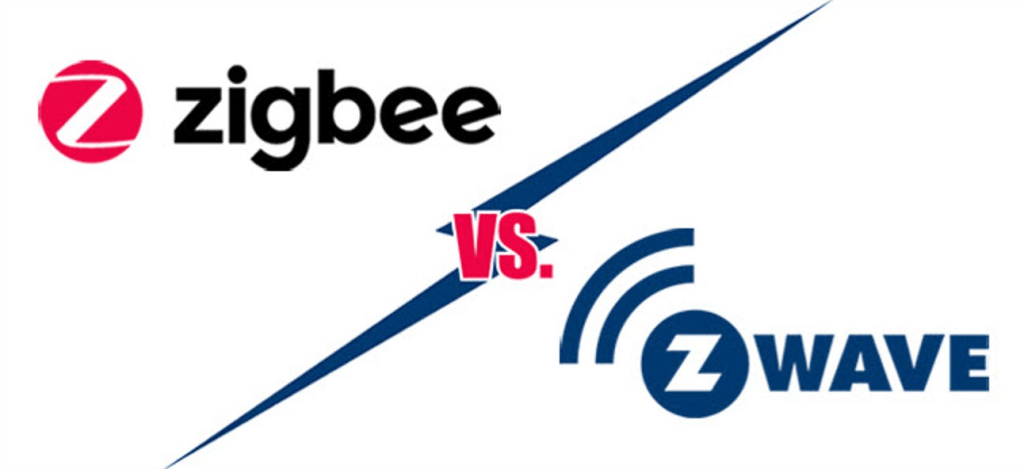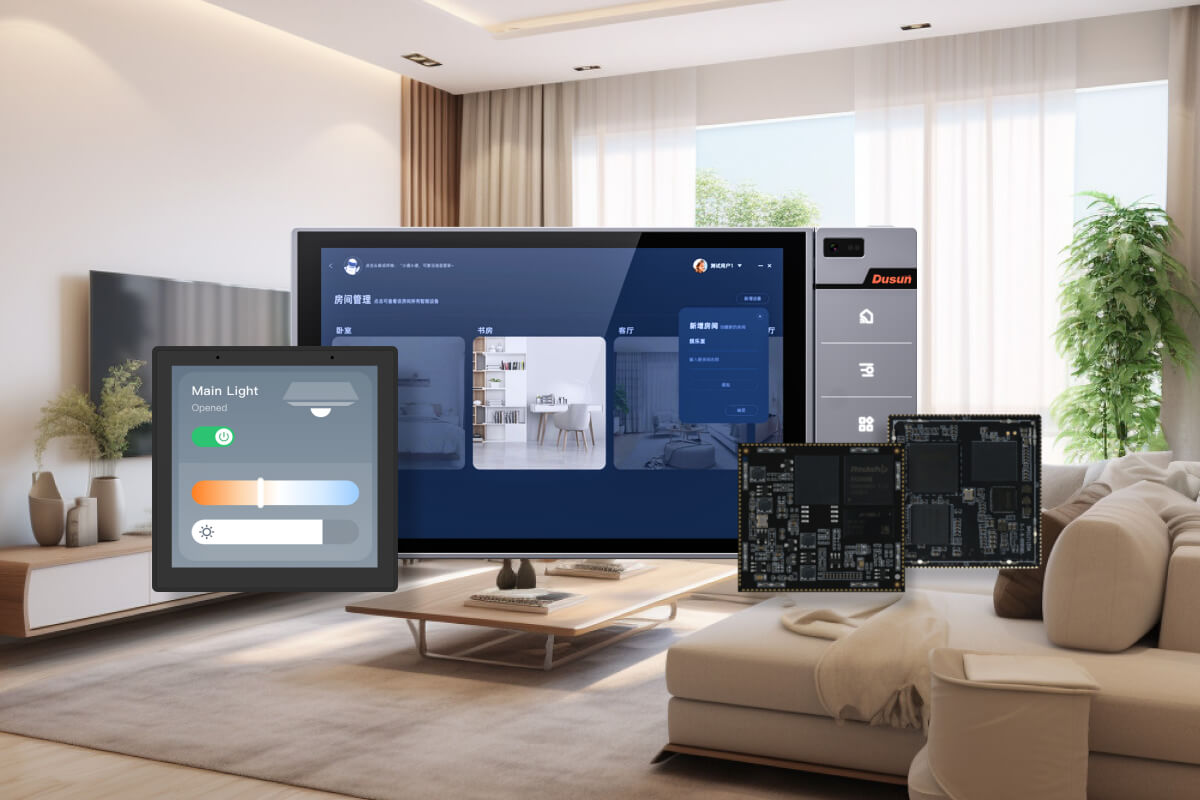As two highly standardized IoT protocols, Zigbee and Z-Wave are mainly used in the smart home field. Zigbee and Z-Wave have certain differences. So, which smart home wireless technology is suitable for you? Acutally, in the smart home, Z-Wave will win slightly due to its interoperability, signal reliability, and security. This article explores the differences between Zigbee and Z-Wave in detail to help you choose the better protocol for your home automation.

What is Zigbee?
Zigbee is a full-stack solution that uses wireless mesh network technology and normally functions in accordance with the IEEE 802.15.4 standard. It is a wireless technology that is based on standards that were developed to enable low-cost, low-power wireless machine-to-machine (M2M) and Internet of things (IoT) networks.
The ZigBee Alliance, now called Connectivity Standards Alliance,which included several major firms such as Philips, Mitsubishi Electric, Epson, Atmel, Texas Instruments, and others, developed the ZigBee standard. This Alliance was founded in 2002 as a non-profit organisation.
ZigBee provides the process of IoT hardware development with flexibility and good interoperability. Because of its key qualities of low cost, low power consumption, and faster wireless communication, the protocol has a variety of applications. It is a preferred technology for smart homes, for example, because it outperforms other wireless technologies in various respects.
To enable Internet-based control and automation of Zigbee devices like smart lights, smart sensors, thermostats and smart switches, a Zigbee gateway plays a significant role in the field of home automation. Connecting a Zigbee gateway to a home automation system like Apple HomeKit, Amazon Alexa, Google Home, or Samsung SmartThings gives consumers a single location from which to manage and operate all of their connected gadgets.
You may be also interested in What is ZigBee in IoT? The Definitive Guide in 2023
What is Z-wave?
Z-Wave, like Zigbee, is a wireless protocol that enables devices to communicate with each other and with a central hub, with a primary focus on connectivity inside the smart home. The Z-Wave gateway is the nerve center of the network, where everything is managed and controlled. It acts as an intermediary between Z-Wave devices and the Internet through a local Wi-Fi or Ethernet connection.
Z-Wave is a flexible and versatile protocol that can be adapted to different use cases and geographic regions through the use of different profiles, it has many variants:
Z-Wave Pluss ( 500 Series or Gen5)
The 500 series, commonly referred to as Z-Wave Plus, is a substantial improvement over Z-Wave. Z-Wave Plus working at up to 100 kbps delivers extra capabilities such as expanded range, longer battery life, and improved noise immunity.
Z-Wave Long Range (Z-Wave LR)
Launched in 2020, Z-Wave LR works at a lower frequency of 800-900 MHz and may cover up to four times the distance of earlier generations, making it appropriate for larger residences and outdoor applications.
Z-Wave Plus V2(700 Series or Gen7)
The latest version of the protocol, announced in 2020, Z-Wave Gen7 has increased security with the latest security standards and protocols such as S2 security and Elliptic Curve Diffie-Hellman (ECDH) key exchange. It also features a quicker data rate of up to 100 kbps, supports larger network sizes, and delivers expanded wireless range, better battery life, and improved dependability. Z-Wave Gen7 is backward compatible with previous versions of the protocol.
Why Z-Wave 800 Series?
The Z-Wave 800 series represents the latest and most advanced generation of the Z-Wave wireless protocol, offering several key advantages over previous versions. The Z-Wave 800 series’ combination of extended range, improved battery life, enhanced security, faster processing, and simplified development make it the optimal choice for a wide range of smart home applications, including IoT gateway, lighting, thermostats, door locks, sensors, and more.
Z-Wave 500, 700, and 800 series represent progressive enhancements in smart home technology, each improving upon its predecessor in terms of range, energy efficiency, and security. The Z-Wave 500 series, while still widely utilized, offers basic connectivity with moderate power consumption. The 700 series advances this by offering greater transmission distance and improved battery life, making it ideal for more demanding applications. The latest, Z-Wave 800 series, extends these capabilities further with up to 1.5 miles of range, minimal energy usage, and introduces top-tier security features including Secure Vault, suitable for high-security applications like smart locks and comprehensive home automation systems. Each series exemplifies a leap forward in accommodating the growing demands of modern smart homes with enhanced performance and safety features.
It is important to note that all of the Z-Wave gateways offered by Dusun IoT feature the most recent Z-Wave version.
You may also be interested in Z-wave: what is it and how does it work?
What is the difference between Zigbee and Z-Wave?
In many aspects, ZigBee and Z-Wave are extremely similar. Both Z-Wave and Zigbee employ radio waves to wirelessly transport data to their respective networks, which enables users to position their devices in a variety of configurations. Both protocols make advantage of mesh networking, which means that individual devices on the network are able to connect with one another to increase the network’s overall capacity.
As for signal range and energy efficiency,both Zigbee and Z-wave have a range of up to 100 meters in open space, which is more than enough for most smart home scenarios. Because both of these protocols makes use of a little amount of power, the devices that implement them will be able to function for far longer stretches of time before requiring either a battery recharge or replacement.
But each of them also has a lot of distinctive qualities that make picking one over the other worthwhile. Zigbee and Z-Wave are significantly different in terms of interoperability, signal reliability, and security components. Here, We provide a detailed comparison table for your reference.
| Zigbee | Z-Wave | |
| Frequency | 2.4 GHz (worldwide), 784 MHz (China), 868 MHz (Europe), 915 MHz (Americas) | Industry standard, supports multiple manufacturers and device types |
| Range | Up to 70 meters indoors, up to 400 meters outdoors | Up to 100 meters indoors, up to 400 meters outdoors |
| Bandwidth | 250 Kbps | 100 Kbps |
| Topology | Mesh network | Mesh network |
| Interference | Can be affected by Wi-Fi and other 2.4 GHz devices | Less susceptible to Wi-Fi interference |
| Devices | Over 1,000 certified devices from various manufacturers | Over 2,400 certified devices mainly from one manufacturer |
| Cost | Moderate to high cost for hubs and devices | Moderate cost for hubs and devices |
| Power consumption | Lower power consumption | Higher power consumption |
| Security | AES-128 encryption | AES-128 encryption, plus with S2 |
| Interoperability | Industry standard, supports multiple manufacturers and device types | Proprietary, mainly used by one manufacturer |
Zigbee vs Z-Wave interoperability
Assume that you need to manage your smart home IoT project using a variety of IoT gateways, platforms, and applications. You have many smart devices that don’t communicate. Why did you buy so many laborious smart home accessories? Appliances in your smart home must communicate easily. Your new home automation product should work with your existing setup.
Interoperability between systems and devices in the smart home is crucial because it enables smooth communication and collaboration between them, which benefits the user’s ease, adaptability, cost-effectiveness, future-proofing, and security. Actually, compared with Zigbee, Z-Wave has better device interoperability.
The interoperability of Z-Wave is one of its primary benefits. Every Z-Wave device must adhere to a rigid set of standards, according to the Z-Wave Alliance. Each Z-Wave-certified controller and every Z-Wave-certified device will function together. ZigBee’s major disadvantage in comparison to Z-wave is its alleged lack of interoperability.
Confusion surrounding their certification scheme has been the main contributor to this. Actually, there are two degrees of certification. One verifies the software, the other the hardware. It is conceivable for a product to have hardware certification but not software.
Devices that are not using the required ZigBee software are nevertheless broadcasting the ZigBee signal. The term “ZigBee-ready” may be used to describe products like this. A customer may purchase the item with the expectation that it will function with all other ZigBee devices, but it won’t. When you need to purchase devices or gateways that use the Zigbee protocol, you need to pay attention to choosing products that have official certification from the Zigbee Alliance.
Zigbee vs Z-Wave signal reliability
Z-wave operates on a frequency spectrum that has been designated exclusively for home automation devices and uses a mesh network topology, making it less susceptible to interference from other wireless home devices like Wi-Fi routers. This makes it possible for Z-wave networks to be extremely dependable and robust, even in settings with lots of wireless devices.
Zigbee also uses a mesh networking design, which increases the network’s dependability and range by utilizing each device as a repeater. This ensures that the system continues to function even if one device in the network malfunctions or loses connectivity because all other devices in the network are still able to communicate with one another.
Zigbee also employs a mechanism known as “self-healing,” which ensures that data still reaches its target in the event of a device failure by automatically rerouting communication through other devices. Because of this, Zigbee networks are exceptionally dependable—even in settings where multiple devices are vying for limited bandwidth.
ZigBee, however, utilizes the extremely congested 2.4 GHz radio spectrum. Frequencies that are crowded can interfere, leading to lost or expansible signals. If your gadget leaves its range, it won’t be as reliable. As a result, Z-Wave does a better job than Zigbee in terms of signal reliability.
Zigbee vs Z-Wave safety
The AES 128 encryption standard is used by both ZigBee and Z-Wave. Banks and governments alike utilize this encryption. Nobody will be able to break the signal encryption and take control of your smart home. In addition, all approved devices must adhere to the Z-Wave Alliance’s new Security 2 (S2) standard.
This most recent security patch almost eliminates the chance that a device may be hacked during inclusion. It cuts the prior procedure’s three stages down to one, hence lowering latency and battery use. Additionally, it aids in preventing the usage of your Z-Wave devices in DDOS assaults. Obviously, both Z-wave and Zigbee exhibit solid security, but Z-Wave’s additional Security 2 standard makes it even better.

Zigbee vs Z-Wave conclusion
In my opinion, if there was only one protocol to choose, Z-Wave would be the winner in the smart home scenario. The good news is that you don’t have to choose just one protocol. Dusun IoT provides multi-protocol gateways that allow devices using different protocols to communicate with each other.
This improves interoperability, increases flexibility and enables seamless communication across disparate networks and devices. Take Dusun Pi3, also known as DSGW-210, for example, which is very popular in smart home scenarios. Dusun Pi3 supports Bluetooth 5.2, ZigBee3.0, Z-WAVE, LoRaWAN, Thread and Matter protocols. You can choose the corresponding module according to your specific needs, which greatly reduces the cost.
Dusun IoT is dedicated to offering you a wide selection of Z-Wave and Zigbee gateways. All Zigbee and Z-wave gateways and sub-devices have undergone market testing and are distinguished by high-cost performance and high performance. Do not hesitate to contact us through the chat box or side form.
Zigbee vs Z-Wave FAQs
Is Alexa Zigbee or Z-Wave?
You may use Zigbee wireless communication technology to link your smart home gadget to Alexa. You don’t need to design a smart home skill or connect a separate hub with Zigbee. Zigbee is a worldwide wireless radio communication standard that allows linked devices to be controlled and monitored.
Which is better for Home Assistant, Zigbee or Z-Wave?
If you intend to continue with the top names in smart home (and perhaps you already have some), but want a speedier connection, Zigbee may be worth considering. Choose Z-Wave for a greater range, perhaps more dependable connections, and a better probability that all compatible devices will function together.
Is an IoT gateway required for Z-Wave and Zigbee?
Yes. A IoT gateway hub is required to set schedules and control remotely away from the home in order to get the most out of your Z-Wave or Zigbee device.



















